Sea Level Rise Impact on Compound Coastal River Flood Risk in Klaipėda City (Baltic Coast, Lithuania)
Abstract
:1. Introduction
2. Materials and Methods
2.1. Study Area Description
2.2. Sea Level Rise at the Klaipėda Strait
2.3. Development of Flood Scenarios
2.4. Model Approach
3. Results
4. Discussion
5. Conclusions
- Compound floods risks and hazards in coastal Klaipėda city are influenced by external Danė River floods, wind-caused sea storm surge, and are due to the climate change effect on the sea level rise in the SE part of the Baltic Sea;
- An integrated approach is needed to assess flood risks and hazards for the evaluation of compound flooding, as when considering together the average rise of the SE Baltic Sea and Curonian Lagoon caused by climate change, its maximum forecast is possible according to the climate change process as well as the extreme Akmena–Danė River floods in the mouth of the river, located in the city of Klaipėda;
- The rising long-term water level in the Klaipėda Strait increases the possibility of a rise in the maximum water level to 3 m. Such an increase corresponds to a 100-year flood and could become more frequent;
- The construction of residential houses in the inundated areas near the Danė River should be suspended in Klaipėda (according to 10-year and 100-year probabilities).
Author Contributions
Funding
Institutional Review Board Statement
Informed Consent Statement
Data Availability Statement
Acknowledgments
Conflicts of Interest
References
- Ghanbari, M.; Arabi, M.; Kao, S.; Obeysekera, J.; Sweet, W. Climate Change and Changes in Compound Coastal-Riverine Flooding Hazard Along the U.S. Coasts. Earth’s Future 2021, 9. [Google Scholar] [CrossRef]
- Bermúdez, M.; Farfán, J.F.; Willems, P.; Cea, L. Assessing the Effects of Climate Change on Compound Flooding in Coastal River Areas. Water Resour. Res. 2021, 57. [Google Scholar] [CrossRef]
- Khanam, M.; Sofia, G.; Koukoula, M.; Lazin, R.; Nikolopoulos, E.I.; Shen, X.; Anagnostou, E.N. Impact of compound flood event on coastal critical infrastructures considering current and future climate. Nat. Hazards Earth Syst. Sci. 2021, 21, 587–605. [Google Scholar] [CrossRef]
- Hsiao, S.-C.; Chiang, W.-S.; Jang, J.-H.; Wu, H.-L.; Lu, W.-S.; Chen, W.-B.; Wu, Y.-T. Flood risk influenced by the compound effect of storm surge and rainfall under climate change for low-lying coastal areas. Sci. Total Environ. 2020, 764, 144439. [Google Scholar] [CrossRef]
- Couasnon, A.; Eilander, D.; Muis, S.; Veldkamp, T.I.E.; Haigh, I.D.; Wahl, T.; Winsemius, H.C.; Ward, P.J. Measuring compound flood potential from river discharge and storm surge extremes at the global scale. Nat. Hazards Earth Syst. Sci. 2020, 20, 489–504. [Google Scholar] [CrossRef] [Green Version]
- Zscheischler, J.; Martius, O.; Westra, S.; Bevacqua, E.; Raymond, C.; Horton, R.M.; van den Hurk, B.; AghaKouchak, A.; Jézéquel, A.; Mahecha, M.D.; et al. A typology of compound weather and climate events. Nat. Rev. Earth Environ. 2020, 1, 333–347. [Google Scholar] [CrossRef]
- Wu, W.; Westra, S.; Leonard, M. Estimating the probability of compound floods in estuarine regions. Hydrol. Earth Syst. Sci. 2021, 25, 2821–2841. [Google Scholar] [CrossRef]
- Bevacqua, E.; Maraun, D.; Haff, I.H.; Widmann, M.; Vrac, M. Multivariate statistical modelling of compound events via pair-copula constructions: Analysis of floods in Ravenna (Italy). Hydrol. Earth Syst. Sci. 2017, 21, 2701–2723. [Google Scholar] [CrossRef] [Green Version]
- Kumbier, K.; Carvalho, R.C.; Vafeidis, A.T.; Woodroffe, C.D. Investigating compound flooding in an estuary using hydrodynamic modelling: A case study from the Shoalhaven River, Australia. Nat. Hazards Earth Syst. Sci. 2018, 18, 463–477. [Google Scholar] [CrossRef] [Green Version]
- Paprotny, D.; Vousdoukas, M.I.; Morales-Nápoles, O.; Jonkman, S.N.; Feyen, L. Compound flood potential in Europe. Hydrology Earth Syst. Sci. Discuss. 2018, 1–34. [Google Scholar] [CrossRef] [Green Version]
- Bevacqua, E.; Maraun, D.; Vousdoukas, M.I.; Voukouvalas, E.; Vrac, M.; Mentaschi, L.; Widmann, M. Higher probability of compound flooding from precipitation and storm surge in Europe under anthropogenic climate change. Sci. Adv. 2019, 5, eaaw5531. [Google Scholar] [CrossRef] [PubMed] [Green Version]
- Paprotny, D.; Morales-Nápoles, O.; Jonkman, S.N. HANZE: A pan-European database of exposure to natural hazards and damaging historical floods since 1870. Earth Syst. Sci. Data 2018, 10, 565–581. [Google Scholar] [CrossRef] [Green Version]
- Blöschl, G.; Hall, J.; Viglione, A.; Perdigão, R.A.; Parajka, J.; Merz, B.; Lun, D.; Arheimer, B.; Aronica, G.T.; Bilibashi, A.; et al. Changing climate both increases and decreases European river floods. Nature 2019, 573, 108–111. [Google Scholar] [CrossRef]
- Blöschl, G.; Hall, J.; Parajka, J.; Perdigão, R.A.P.; Merz, B.; Arheimer, B.; Aronica, G.T.; Bilibashi, A.; Bonacci, O.; Borga, M.; et al. Changing climate shifts timing of European floods. Science 2017, 357, 588–590. [Google Scholar] [CrossRef] [Green Version]
- Thober, S.; Kumar, R.; Wanders, N.; Marx, A.; Pan, M.; Rakovec, O.; Samaniego, L.; Sheffield, J.; Wood, E.F.; Zink, M. Multi-model ensemble projections of European river floods and high flows at 1.5, 2, and 3 degrees global warming. Environ. Res. Lett. 2018, 13, 014003. [Google Scholar] [CrossRef]
- Donnelly, C.; Greuell, W.; Andersson, J.; Gerten, D.; Pisacane, G.; Roudier, P.; Ludwig, F. Impacts of climate change on European hydrology at 1.5, 2 and 3 degrees mean global warming above preindustrial level. Clim. Change 2017, 143, 13–26. [Google Scholar] [CrossRef] [Green Version]
- Kundzewicz, Z.W.; Krysanova, V.; Dankers, R.; Hirabayashi, Y.; Kanae, S.; Hattermann, F.F.; Huang, S.; Milly, P.C.D.; Stoffel, M.; Driessen, P.; et al. Differences in flood hazard projections in Europe – their causes and consequences for decision making. Hydrol. Sci. J. 2017, 62, 1–14. [Google Scholar] [CrossRef] [Green Version]
- Stonevičius, E.; Valiuškevičius, G.; Rimkus, E.; Kažys, J. Climate induced changes of Lithuanian rivers runoff in 1960–2009. Water Resour. 2014, 41, 592–603. [Google Scholar] [CrossRef]
- Šarauskienė, D.; Akstinas, V.; Kriaučiūnienė, J.; Jakimavičius, D.; Bukantis, A.; Kažys, J.; Pliuraitė, V. Projection of Lithuanian river runoff, temperature and their extremes under climate change. Hydrol. Res. 2018, 49, 344–362. [Google Scholar] [CrossRef]
- Rimkus, E.; Kažys, J.; Bukantis, A. Gausių kritulių Lietuvoje prognozė XXI amžiui pagal regioninį CCLM modelį (Forecast of heavy rainfall in Lithuania for the 21st century according to the regional CCLM model). Geografija 2009, 45, 122–130. [Google Scholar]
- On the approval of the list of criteria for extreme events. Resolution of the Government of the Republic of Lithuania: 9 March 2006 No. 29-1004. Lietuvos Respublikos Vyriausybės Nutarimas dėl Ekstremaliųjų įvykių Kriterijų Sąrašo Patvirtinimo 2006m. Kovo 9 d. Nr. 29-1004. Available online: https://e-seimas.lrs.lt/portal/legalAct/lt/TAD/TAIS.271723/asr (accessed on 5 May 2021).
- Rimkus, E.; Kažys, J.; Bukantis, A.; Krotovas, A. Temporal variation of extreme precipitation events in Lithuania. Oceanologia 2011, 53, 259–277. [Google Scholar] [CrossRef] [Green Version]
- Keršytė, D.; Rimkus, E.; Kažys, J. Klimato rodiklių scenarijai Lietuvos teritorijoje XXI a [Scenarios of climate indicators in the territory of Lithuania in the 21st century]. Geol. Geogr. 2015, 1. [Google Scholar] [CrossRef]
- Jakimavičius, D.; Kriaučiūnienė, J.; Šarauskienė, D. Impact of climate change on the Curonian Lagoon water balance components, salinity and water temperature in the 21st century. Oceanologia 2018, 60, 378–389. [Google Scholar] [CrossRef]
- Update of the Preliminary Flood Risk Assessment 2011-2018. Environmental Protection Agency. Preliminaraus Potvynių Rizikos Vertinimo Atnaujinimas 2011—2018 m. Aplinkos Apsaugos Agentūra. Available online: https://vanduo.old.gamta.lt/files/Preliminary_flood_risk_assessment_2011_2018.pdf (accessed on 5 May 2021).
- Romanescu, G.; Stoleriu, C.C. Exceptional floods in the Prut basin, Romania, in the context of heavy rains in the summer of 2010. Nat. Hazards Earth Syst. Sci. 2017, 17, 381–396. [Google Scholar] [CrossRef] [Green Version]
- Kreienkamp, F.; Philip, S.Y.; Tradowsky, J.S.; Kew, S.F.; Lorenz, P.; Arrighi, J.; Belleflamme, A.; Bettmann, T.; Caluwaerts, S.; Chan, S.C.; et al. Rapid Attribution of Heavy Rainfall Events Leading to the Severe Flooding in Western Europe During July 2021. Available online: http://hdl.handle.net/1854/LU-8732135 (accessed on 9 September 2021).
- Moftakhari, H.R.; Salvadori, G.; AghaKouchak, A.; Sanders, B.; Matthew, R.A. Compounding effects of sea level rise and fluvial flooding. Proc. Natl. Acad. Sci. USA 2017, 114, 9785–9790. [Google Scholar] [CrossRef] [Green Version]
- Allen, M.R.; Dube, O.P.; Solecki, W.; Aragón-Durand, F.; Cramer, W.; Humphreys, S.; Kainuma, M.; Kala, J.; Mahowald, N.; Mulugetta, Y.; et al. Framing and Context. In Global Warming of 1.5 °C. An IPCC Special Report on the Impacts of Global Warming of 1.5 °C Above Pre-Industrial Levels and Related Global Greenhouse Gas Emission Pathways, in the Context of Strengthening the Global Response to the Threat of Climate Change, Sustainable Development, and Efforts to Eradicate Poverty; 2018; Available online: https://www.ipcc.ch/sr15/chapter/chapter-1/ (accessed on 9 September 2021).
- IPCC Summary for Policymakers. Climate Change and Land: An IPCC Special Report on Climate Change, Desertification, Land Degradation, Sustainable Land Management, Food Security, and Greenhouse Gas Fluxes in Terrestrial Ecosystems. 2019. Available online: https://www.ipcc.ch/srccl/chapter/summary-for-policymakers/ (accessed on 9 September 2021).
- WMO. Provisional Report: The State of the Global Climate 2020. Available online: https://public.wmo.int/en/our-mandate/climate/wmo-statement-state-of-global-climate (accessed on 17 August 2021).
- Omstedt, A.; Elken, J.; Lehmann, A.; Leppäranta, M.; Meier HE, M.; Myrberg, K.; Rutgersson, A. Progress in physical oceanography of the Baltic Sea during the 2003–2014 period. Prog. Oceanogr. 2014, 128, 139–171. [Google Scholar] [CrossRef]
- Gräwe, U.; Klingbeil, K.; Kelln, J.; Dangendorf, S. Decomposing Mean Sea Level Rise in a Semi-Enclosed Basin, the Baltic Sea. J. Clim. 2019, 32, 3089–3108. [Google Scholar] [CrossRef]
- Approval of the Preliminary Flood Risk Assessment Report. Order of the Minister of the Environment of the Republic of Lithuania: 11 January 2012 No. D1-23. Lietuvos Respublikos Aplinkos Ministro Įsakymas dėl Preliminaraus Potvynių Rizikos Vertinimo Ataskaitos Patvirtinimo 2012m. Sausio 11 d. Nr. D1-23. Available online: https://e-seimas.lrs.lt/portal/legalAct/lt/TAD/TAIS.417035?jfwid=q86m1vvfu (accessed on 17 May 2021).
- BACC II Author Team. Second Assessment of Climate Change for the Baltic Sea Basin; Springer: Cham, Swizerland, 2015; ISBN 978-3-31-916005-4. [Google Scholar]
- Richter, A.; Groh, A.; Dietrich, R. Geodetic observation of sea-level change and crustal deformation in the Baltic Sea region. Phys. Chem. Earth Parts A/B/C 2012, 53–54, 43–53. [Google Scholar] [CrossRef]
- Poutanen, M.; Steffen, H. Land uplift at Kvarken Archipelago/high coast UNESCO World Heritage area. Geophysica 2015, 50, 49–64. [Google Scholar]
- On the Approval of the Program for the Development of the Water Sector for 2017–2023; Resolution of the Government of the Republic of Lithuania: 1 Februrary 2017 No. 88. Lietuvos Respublikos Vyriausybės Nutarimas dėl Vandenų Srities Plėtros 2017-2023 Metų Programos Patvirtinimo 2017m. Vasario 1 d. Nr. 88. Available online: https://e-seimas.lrs.lt/portal/legalAct/lt/TAD/4606c421eea211e6be918a531b2126ab?jfwid=-wd7z6lfxo (accessed on 25 May 2021).
- Stonevičius, E.; Valiuškevičius, G.; Rimkus, E.; Kažys, J. Potvynių Smeltėje Poveikio Švelninimo Ir Adapatacijos Prie Jų Galimybės Atsižvelgiant Į Numatomus Klimato Pokyčius (Possibilities Of Mitigation And Adaptation To The Effects Of Floods In Smelte Taking Into Account The Expected Climate Change); Vilnius University: Vilnius, Lithuania, 2010. [Google Scholar] [CrossRef]
- Dubra, V.; Abromas, J. Flood risk and planning of recreational territories in the Akmena-Danė River Basin Of Western Lithuania/Potvynių rizika ir rekreacinių teritorijų planavimas Vakarų Lietuvos Akmenos–Danės Upės Baseine. J. Arch. Urban. 2012, 36, 99–106. [Google Scholar] [CrossRef]
- Jakimavičius, D.; Kovalenkovienė, M. Long-term water balance of the Curonian Lagoon in the context of anthropogenic factors and climate change. Baltica 2010, 23, 33–46. [Google Scholar]
- Dailidienė, I.; Davulienė, L.; Kelpšaitė, L.; Razinkovas, A. Analysis of the Climate Change in Lithuanian Coastal Areas of the Baltic Sea. J. Coast. Res. 2012, 282, 557–569. [Google Scholar] [CrossRef]
- Dailidienė, I.; Davulienė, L.; Tilickis, B.; Stankevičius, A.; Myrberg, K. Sea level variability at the Lithuanian coast of the Baltic Sea. Boreal Environ. Res. 2006, 11, 109–121. [Google Scholar]
- Dailidienė, I.; Baudler, H.; Chubarenko, B.; Navrotskaya, S. Long term water level and surface temperature changes in the lagoons of the southern and eastern Baltic. Oceanologia 2011, 53, 293–308. [Google Scholar] [CrossRef] [Green Version]
- Meier, H.; Broman, B.; Kjellström, E. Simulated sea level in past and future climates of the Baltic Sea. Clim. Res. 2004, 27, 59–75. [Google Scholar] [CrossRef]
- Wolski, T.; Wiśniewski, B. Characteristics and Long-Term Variability of Occurrences of Storm Surges in the Baltic Sea. Atmosphere 2021, 12, 1679. [Google Scholar] [CrossRef]
- Implementation of the Floods Directive. Environmental Protection Agency 2018. Potvynių Direktyvos įgyvendinimas. Aplinkos Apsaugos Agentūra. Available online: https://vanduo.old.gamta.lt/cms/index?rubricId=6d87deab-3ecc-412a-9b66-7fd6361f26ba (accessed on 28 April 2021).
- Kilkus, K.; Stonevičius, E. Lietuvos Vandenų Geografija (Geography Of Lithuanian Waters); Vilnius University: Vilnius, Lithuania, 2011. [Google Scholar]
- Lietuvos Nacionalinis Atlasas (Lithuanian National Atlas). Nacionalinė Žemės Tarnyba Prie Žemės Ūkio Ministerijos [National Land Service under the Ministry of Agriculture]: Vilnius, Lithuania, 2014; ISBN 9786094204050.
- Meier, H.E.M.; Kniebusch, M.; Dieterich, C.; Gröger, M.; Zorita, E.; Elmgren, R.; Myrberg, K.; Ahola, M.; Bartosova, A.; Bonsdorff, E.; et al. Climate Change in the Baltic Sea Region: A Summary. Earth Syst. Dynam. Discuss. 2021. [preprint] In review. [Google Scholar] [CrossRef]
- Stocker, T.F.; Qin, D.; Plattner, G.K.; Alexander, L.V.; Allen, S.K.; Bindoff, N.L.; Bréon, F.M.; Church, J.A.; Cubasch, U.; Emori, S.; et al. Technical summary. In Climate Change 2013: The Physical Science Basis. Contribution Of Working Group I to the Fifth Assessment Report of the Intergovernmental Panel on Climate Change; Cambridge University Press: Cambridge, UK.
- IPCC 2021: Summary for Policymakers. In Climate Change 2021: The Physical Science Basis Contribution of Working Group I to the Sixth Assessment Report of the Intergovernmental Panel on Climate Change; Masson-Delmotte, V.; Zhai, P.A.; Pirani, S.L.; Connors, C.; Péan, S.; Berger, N.; Caud, Y.; Chen, L.; Goldfarb, M.I.; Gomis, M.; et al. (Eds.) Cambridge University Press; in press.
- Climate Change in the Baltic Sea. 2021 Fact Sheet. Baltic Sea Environment Proceedings no. 180. HELCOM/Baltic Earth 2021; Helsinki Commission – HELCOM: Helsinki, Finland.
- IPCC 2019: Technical Summary. In IPCC Special Report on the Ocean and Cryosphere in a Changing Climate; Pörtner, H.-O.; Roberts, D.C.; Masson-Delmotte, V.; Zhai, P.; Tignor, M.; Poloczanska, E.; Mintenbeck, K.; Alegría, A.; Nicolai, M.; Okem, A. (Eds.) In press; Available online: https://www.ipcc.ch/site/assets/uploads/sites/3/2019/12/SROCC_FullReport_FINAL.pdf (accessed on 9 September 2021).
- Environmental Protection Agency under the Ministry of Environment. 2014. River Valley Digital Terrain Model. Retrieved From Spatial Information Portal of Lithuania. Available online: https://www.geoportal.lt/metadata-catalog/catalog/search/resource/details.page?uuid=%7BB66494B9-7495-8344-D0F0-8C4857014F76%7D (accessed on 9 September 2021).
- Leppäranta, M.; Myrberg, K. Physical Oceanography of the Baltic Sea; Springer: Berlin/Heidelberg, Germany, 2009; ISBN 978-3-540-79703-6. [Google Scholar]
- Zakharchuk, E.A.; Tikhonova, N.; Zakharova, E.; Kouraev, A.V. Spatiotemporal structure of Baltic free sea level oscillations in barotropic and baroclinic conditions from hydrodynamic modelling. Ocean Sci. 2021, 17, 543–559. [Google Scholar] [CrossRef]
- Jakimavičius, D.; Kriauciuniene, J. The climate change impact on the water balance of the Curonian Lagoon. Water Resour. 2013, 40, 120–132. [Google Scholar] [CrossRef]
- Arustienė, J.; Bukantis, A.; Damušytė, A.; Jarmalavičius, D.; Kažys, J.; Kriukaitė, J.; Ramanauskienė, V.; Rimkus, E.; Stonevičius, E.; Valiuškevičius, G.; et al. Klimato Kaita Klaipėdos Mieste Ir Rajone: Poveikis, Kaina Ir Prisitaikymas (Climate Change In Klaipeda City And District: Impact, Price And Adaptation); Vilnius University: Vilnius, Lithuania, 2012. [Google Scholar]
- Soomere, T.; Pindsoo, K. Spatial variability in the trends in extreme storm surges and weekly-scale high water levels in the eastern Baltic Sea. Cont. Shelf Res. 2016, 115, 53–64. [Google Scholar] [CrossRef]
- Weisse, R.; Bellafiore, D.; Menendez, M.; Méndez, F.; Nicholls, R.J.; Umgiesser, G.; Willems, P. Changing extreme sea levels along European coasts. Coast. Eng. 2013, 87, 4–14. [Google Scholar] [CrossRef] [Green Version]
- Torresan, S.; Critto, A.; Rizzi, J.; Marcomini, A. Assessment of coastal vulnerability to climate change hazards at the regional scale: The case study of the North Adriatic Sea. Nat. Hazards Earth Syst. Sci. 2012, 12, 2347–2368. [Google Scholar] [CrossRef]
- Camus, P.; Tomás, A.; Díaz-Hernández, G.; Rodríguez, B.; Izaguirre, C.; Losada, I. Probabilistic assessment of port operation downtimes under climate change. Coast. Eng. 2019, 147, 12–24. [Google Scholar] [CrossRef]
- Vousdoukas, M.I.; Mentaschi, L.; Hinkel, J.; Ward, P.J.; Mongelli, I.; Ciscar, J.-C.; Feyen, L. Economic motivation for raising coastal flood defenses in Europe. Nat. Commun. 2020, 11, 2119. [Google Scholar] [CrossRef] [PubMed]
- Suursaar, Ü.; Jaagus, J.; Tõnisson, H. How to quantify long-term changes in coastal sea storminess? Estuarine Coast. Shelf Sci. 2015, 156, 31–41. [Google Scholar] [CrossRef]
- EU. Directive 2008/56/EC of the European Parliament and of the Council of 17 June 2008 Establishing a Framework for Community Action in the Field of Marine Environmental Policy (Marine Strategy Framework Directive) (Official Journal of the European Union, 2008). Available online: https://eur-lex.europa.eu/legal-content/EN/TXT/HTML/?uri=CELEX:52020DC0259&from=EN (accessed on 13 June 2021).
- EU. Communication from the Commission to the European Parliament, the Council, the European Economic and Socal Committee and the Committee of the Regions. Forging a Climate-Resilient Europe—The New EU Strategy on Adaptation to Climate Change. Off. J. Eur. Union 2021. Available online: https://eur-lex.europa.eu/legal-content/EN/TXT/?uri=COM:2021:82:FIN (accessed on 16 August 2021).
- General Plan of Klaipėda City municipality. Solutions. Explanatory Note. Administration Of Klaipėda City Municipality 2019. Klaipėdos Miesto Savivaldybės Bendrasis Planas. Sprendiniai. Aiškinamasis Raštas. Klaipėdos Miesto Savivaldybės Adminis-Tracija 2019. Available online: https://www.klaipeda.lt/data/public/uploads/2021/03/klaipedos-bp-aiskinamasis-rastas-2021-03-09.pdf (accessed on 15 April 2021).
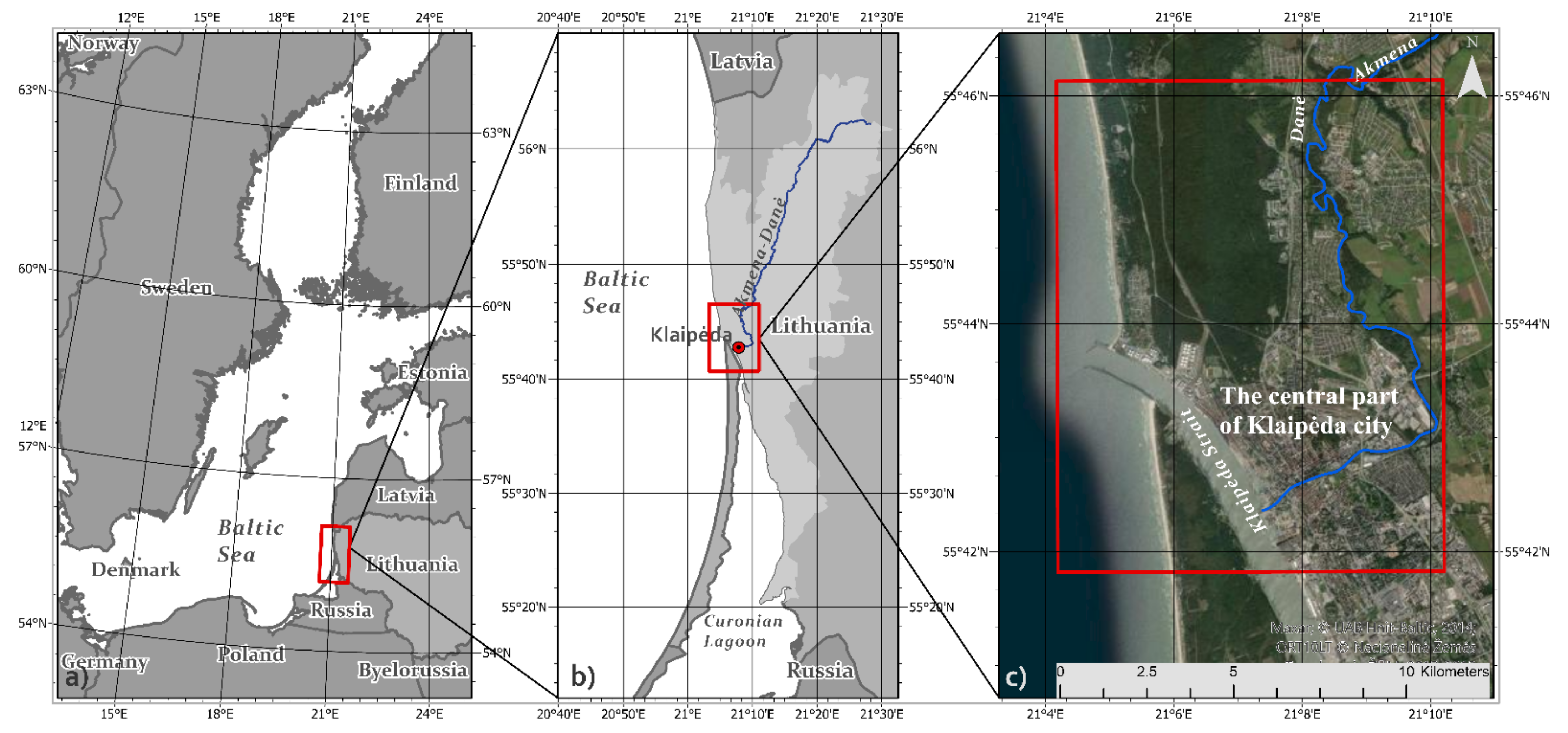
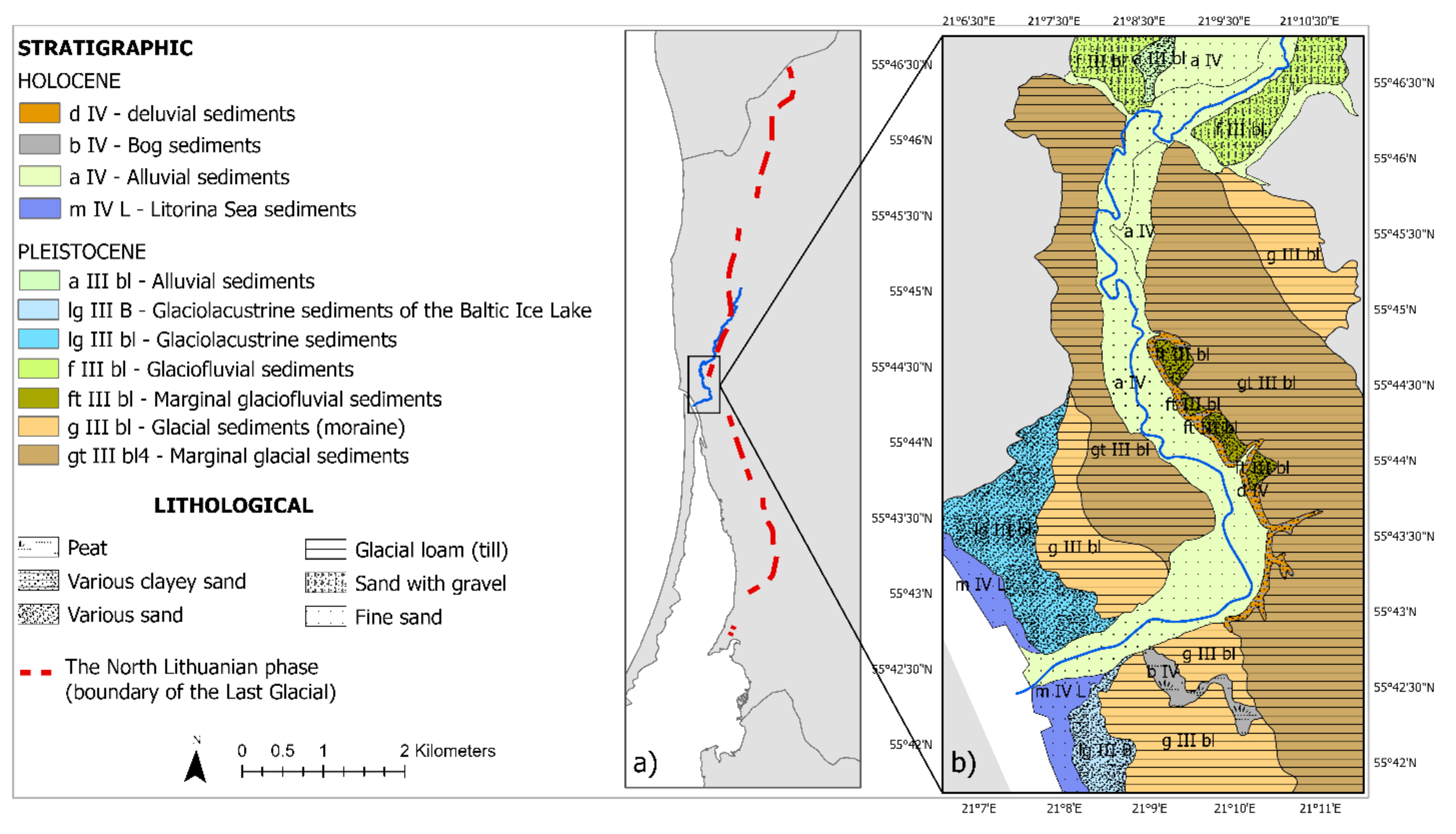

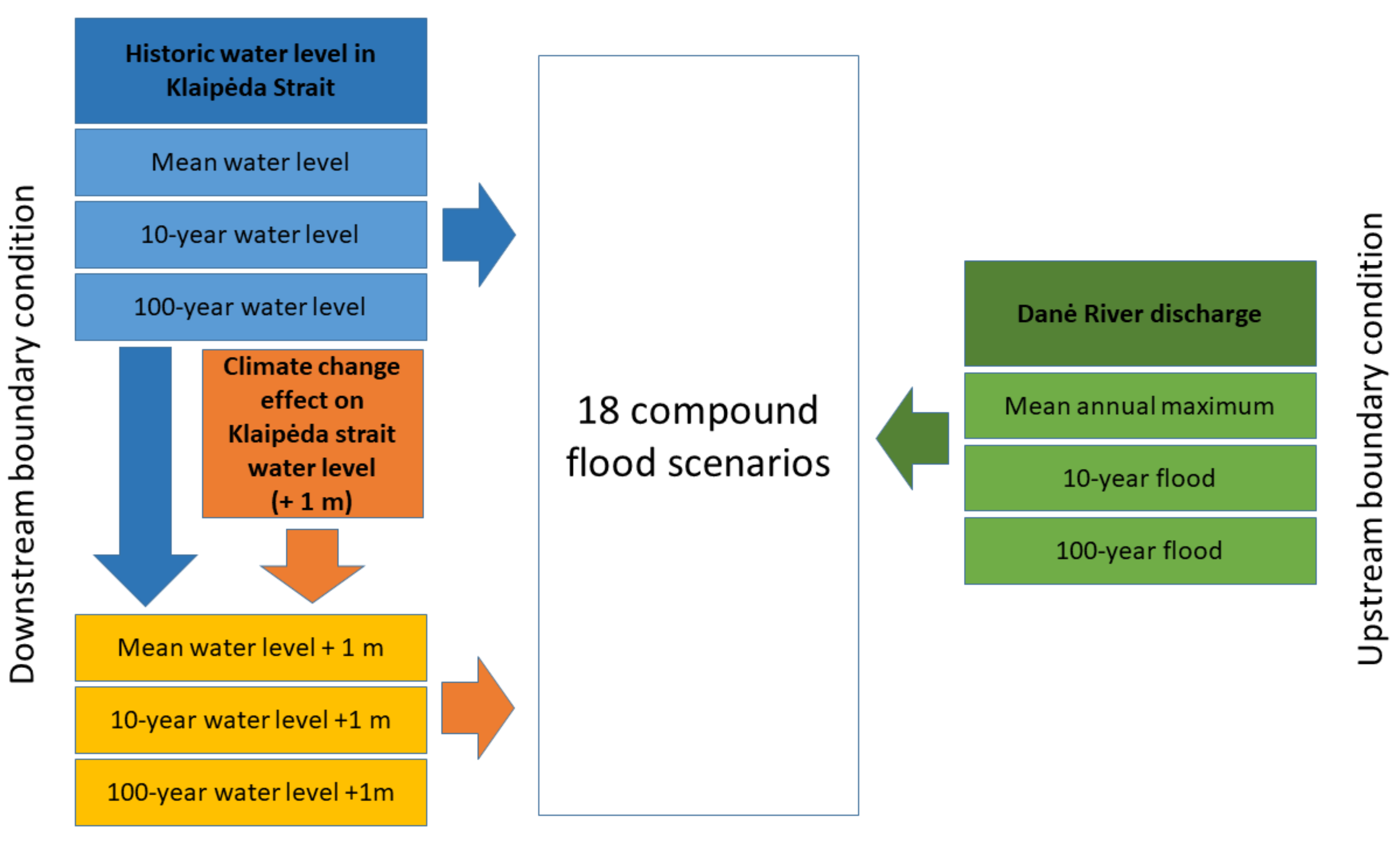
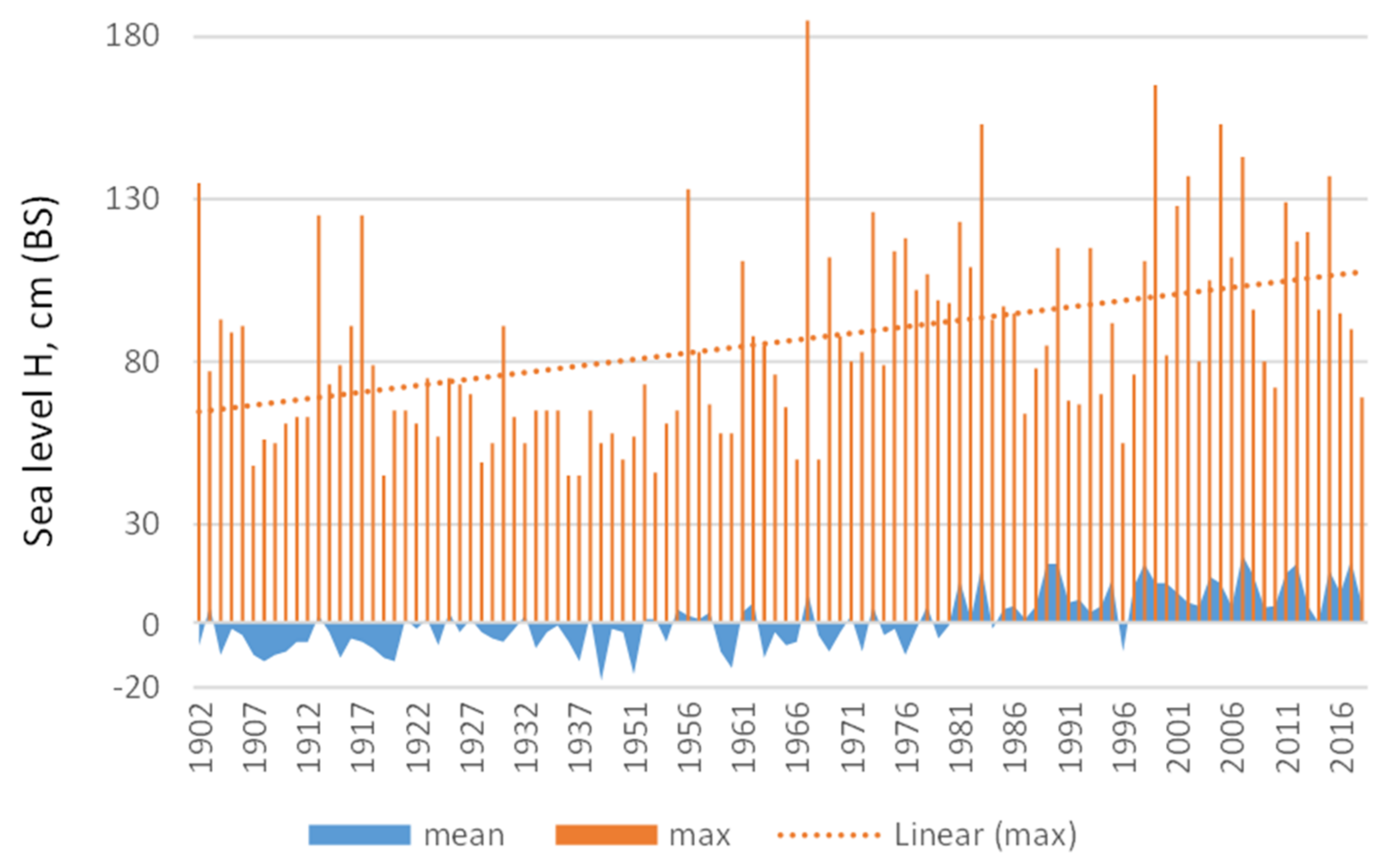

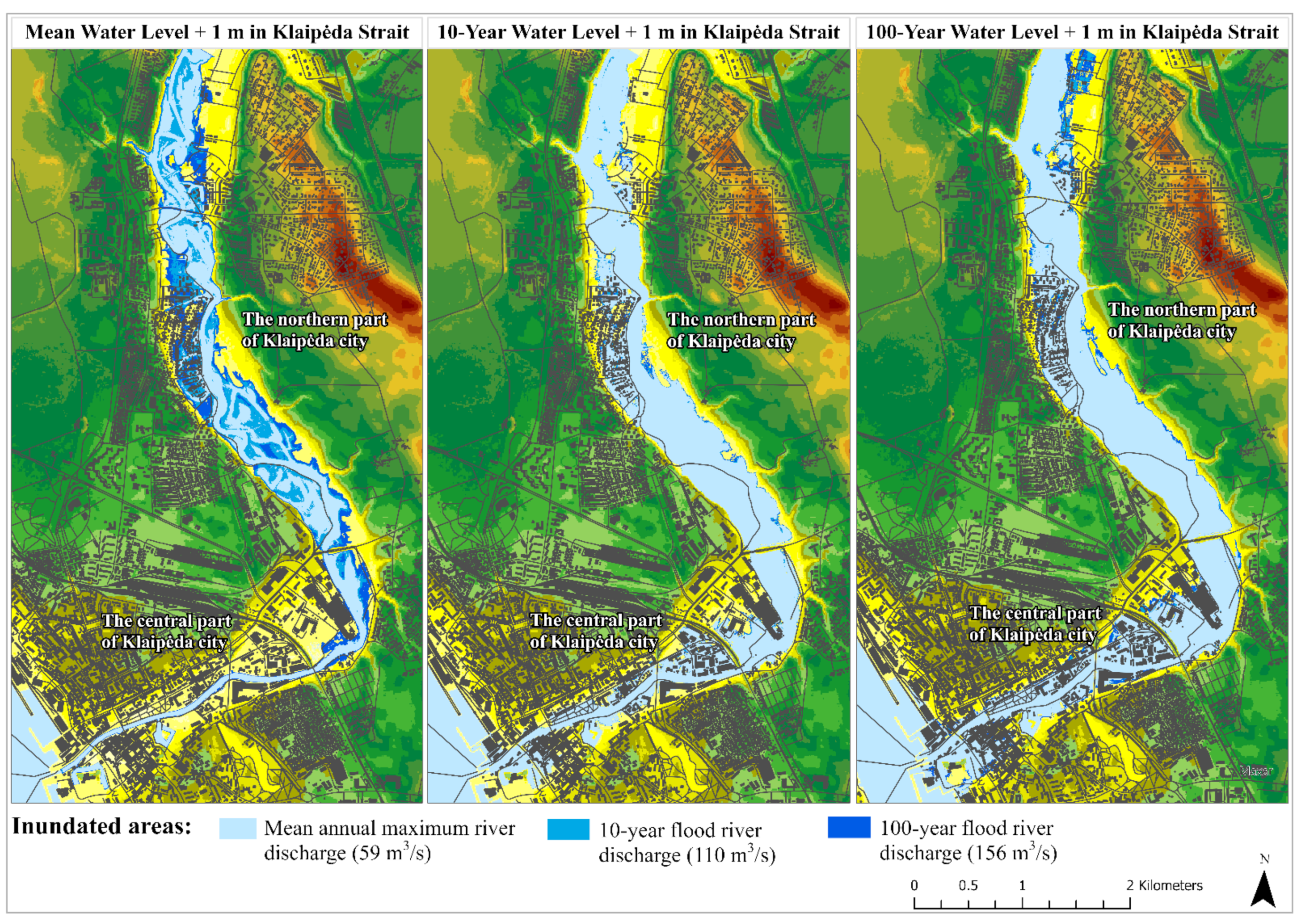

| Danė River Discharge Probabilities | Mean Water Level (0 m) | 10-Year Water Level (1.4 m) | 100-Year Water Level (2 m) | |||
|---|---|---|---|---|---|---|
| Built-Up Areas (m2) and Their Share of the City (%) | Non-Built-Up Areas (m2) and Their Share of the City (%) | Built-Up Areas (m2) and Their Share of the City (%) | Non-Built-Up Areas (m2) and Their Share of the City (%) | Built-Up Areas (m2) and Their Share of the City (%) | Non-Built-Up Areas (m2) and Their Share of the City (%) | |
| Mean annual maximum (59 m3/s) | 59,050 m2 0.06% | 778,876 m2 0.79% | 150,266 m2 0.15% | 1,253,247 m2 1.28% | 460,798 m2 0.47% | 1,545,648 m2 1.58% |
| 10-year flood (110 m3/s) | 120,542 m2 0.12% | 1,177,366 m2 1.20% | 270,219 m2 0.28% | 1,554,002 m2 1.59% | 564,255 m2 0.57% | 1,728,977 m2 1.76% |
| 100-year flood (156 m3/s) | 172,234 m2 0.18% | 1,348,307 m2 1.38% | 457,800 m2 0.48% | 1,771,515 m2 1.81% | 746,531 m2 0.76% | 1,920,754 m2 1.96% |
| Danė River Discharge Probabilities | Mean Water Level (1 m) | 10-Year Water Level (2.4 m) | 100-Year Water Level (3 m) | |||
|---|---|---|---|---|---|---|
| Built-Up Areas (m2) and Their Share of the City (%) | Non-Built-Up Areas (m2) and Their Share of the City (%) | Built-Up Areas (m2) and Their Share of the City (%) | Non-Built-Up Areas (m2) and Their Share of the City (%) | Built-Up Areas (m2) and Their Share of the City (%) | Non-Built-Up Areas (m2) and Their Share of the City (%) | |
| Mean annual maximum (59 m3/s) | 72,144 m2 0.07% | 859,115 m2 0.88% | 713,795 m2 0.72% | 1,698,349 m2 1.73% | 1,155,293 m2 1.18% | 1,890,011 m2 1.93% |
| 10-year flood (110 m3/s) | 185,284 m2 0.19% | 1,351,505 m2 1.38% | 754,491 m2 0.77% | 1,742,911 m2 1.78% | 1,207,262 m2 1.23% | 1,950,005 m2 1.99% |
| 100-year flood (156 m3/s) | 277,191 m2 0.28% | 1,599,240 m2 1.63% | 798,927 m2 0.82% | 1,794,667 m2 1.84% | 1,369,597 m2 1.40% | 2,080,402 m2 2.12% |
| Danė River Discharge Probabilities | Mean Water Level | 10-Year Water Level | 100-Year Water Level | |||
|---|---|---|---|---|---|---|
| Built-Up Areas (m2) and Their Share of the City (%) | Non-Built-Up Areas (m2) and Their Share of the City (%) | Built-Up Areas (m2) and Their Share of the City (%) | Non-Built-Up Areas (m2) and Their Share of the City (%) | Built-Up Areas (m2) and Their Share of the City (%) | Non-Built-Up Areas (m2) and Their Share of the City (%) | |
| Mean annual maximum (59 m3/s) | 1309 m2 0.01% | 80,239 m2 0.08% | 563,529 m2 0.58% | 445,102 m2 1.45% | 694,495 m2 0.71% | 344,363 m2 0.35% |
| 10-year flood (110 m3/s) | 64,742 m2 0.07% | 174,139 m2 0.18% | 484,272 m2 0.49% | 188,909 m2 0.19% | 643,007 m2 0.66% | 221,028 m2 0.23% |
| 100-year flood (156 m3/s) | 104,957 m2 0.11% | 250,933 m2 0.25% | 341,127 m2 0.35% | 23,152 m2 0.02% | 623,066 m2 0.64% | 159,648 m2 0.16% |
| Without Climate Change Impact | With Climate Change Impact | |||||
|---|---|---|---|---|---|---|
| Mean Water Level (0) | 10-Year Water Level (1.4 m) | 100-Year Water Level (2 m) | Mean Water Level (1 m) | 10-Year Water Level (2.4 m) | 100-Year Water Level (3 m) | |
| Mean annual maximum river discharge (59 m3/s) | 60 | 178 | 359 | 85 | 549 | 767 |
| 10-year flood river discharge (10 m3/s) | 144 | 327 | 491 | 244 | 573 | 858 |
| 100-year flood river discharge (156 m3/s) | 209 | 533 | 668 | 400 | 616 | 940 |
| Without Climate Change Impact | With Climate Change Impact | |||||
|---|---|---|---|---|---|---|
| Mean Water Level (0) | 10-Year Water Level (1.4 m) | 100-Year Water Level (2 m) | Mean Water Level (1 m) | 10-Year Water Level (2.4 m) | 100-Year Water Level (3 m) | |
| Mean annual maximum river discharge (59 m3/s) | 8008 | 13,880 | 25,576 | 8989 | 31,262 | 37,225 |
| 10-year flood river discharge (10 m3/s) | 10,052 | 16,429 | 27,515 | 11,308 | 31,772 | 39,789 |
| 100-year flood river discharge (156 m3/s) | 10,621 | 24,530 | 31,968 | 15,811 | 32,146 | 42,753 |
Publisher’s Note: MDPI stays neutral with regard to jurisdictional claims in published maps and institutional affiliations. |
© 2022 by the authors. Licensee MDPI, Basel, Switzerland. This article is an open access article distributed under the terms and conditions of the Creative Commons Attribution (CC BY) license (https://creativecommons.org/licenses/by/4.0/).
Share and Cite
Čepienė, E.; Dailidytė, L.; Stonevičius, E.; Dailidienė, I. Sea Level Rise Impact on Compound Coastal River Flood Risk in Klaipėda City (Baltic Coast, Lithuania). Water 2022, 14, 414. https://doi.org/10.3390/w14030414
Čepienė E, Dailidytė L, Stonevičius E, Dailidienė I. Sea Level Rise Impact on Compound Coastal River Flood Risk in Klaipėda City (Baltic Coast, Lithuania). Water. 2022; 14(3):414. https://doi.org/10.3390/w14030414
Chicago/Turabian StyleČepienė, Erika, Lina Dailidytė, Edvinas Stonevičius, and Inga Dailidienė. 2022. "Sea Level Rise Impact on Compound Coastal River Flood Risk in Klaipėda City (Baltic Coast, Lithuania)" Water 14, no. 3: 414. https://doi.org/10.3390/w14030414
APA StyleČepienė, E., Dailidytė, L., Stonevičius, E., & Dailidienė, I. (2022). Sea Level Rise Impact on Compound Coastal River Flood Risk in Klaipėda City (Baltic Coast, Lithuania). Water, 14(3), 414. https://doi.org/10.3390/w14030414






